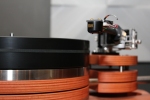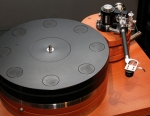Turntables are such beautiful sculptures! While Dr Feickert’s Woodpecker is one smart looking turntable, its brother, the ‘Twin’ is feast for the eyes! The unit we are setting up for a customer is finished in a gorgeous warm beech finish. The Twin in black somehow didn’t quite carry it off as well as compared to the one we have here.
The Twin is the second model down from the flagship Triple, named for its ability to mount up to three tonearms. The Twin, doesn’t mount anything more than one tonearm so its name must be derived from something else. That something else is the two-piece ‘sandwich’ construction, hence ‘Twin’. Looking at the picture of the turntable, you can see the base plinth made from beech ply, then the platter shaped/sized sub platter made from a sandwich of a thick slab of steel disc and beech ply on top. The idea behind this is simple; the steel disc gives mass to the structure while the laminated beech ply topping provides self-damping. A second slab of steel/beech ply layer is inverted over the first so that the two beech ply slabs face each other. Two steel rods separate the two sandwich structure and the steel rods also extends all the way to the armboard which is clamped by two thick round discs of beech ply. The arm sits on a third slab of beech ply raised over the two-piece arm support. The black composite platter sits over an inverted bearing.
The motor is outboard and Dr Feickert saw fit to provide electronic speed control to the 3-speeds – an additional 78 rpm together with the usual 33 and 45 rpm. Housed in a massive steel cylinder, the motor vibration is all but damped. A flat rubber belt transfers the drive from the motor to the rim of the platter. The platter has no mat of any sort and neither is a clamp provided. More of this later.
This is one heavy turntable! Weighing some 40+ Kgs, a strong shelf is strongly recommended. The turntable stands on 3 feet but unusually, it has one footer in front and two footers behind; usually it is the other way. Perhaps the location of the feet is determined by the weight distribution.
The arm and cartridge of choice is the Triplanar MKVII UII and the Miyajima Shilabe MC cartridge. The Triplanar is a very established and well-known tonearm so instead we focus on the relatively less well-known Miyajima Shilabe. Miyajima is obviously Japanese and like the best sounding cartridges, Mr. Miyajima hand-makes and selects only the best samples to be sold. And like many Japanese exoticas, you can expect exotic hardwoods to be used for the body, rather than aluminum/magnesium/titanium. The Shilabe is encased in a hand cut block of African ebony, obviously the resonance characteristic of this material plays a very big part in the sonic characteristic of this cartridge. The rounded body does make setup a little trickier than most but like all cartridges, we should tune with our ears. Tracking force required is a little heavier than usual at 2.5 – 3.2gms – again use your ears to determine what is the optimal down force – for secure tracking and sound quality desired. The design of the Shilabe is unique for the pole pieces are shaped like a cross instead of the usual square block. Miyajima takes great pains to highlight this fact so I guess it should be a big determining factor in the superlative performance of this cartridge. But if you are after good sound, the Miyajima Shilabe is one that had the measure of a high-end cartridge in terms of sound but a decidedly mid-range price tag. That, is what I call value for money!
Mounting the arm and cartridge on the Feickert Twin is a straightforward affair. The turntable has nothing to tune except for the placement of the motor to the spindle distance – make sure the belt is juuuuusssst taut enough without overdoing it. As mentioned earlier, a strong and damped platform is essentially for a suspension-less turntable. You can experiment with different platforms – glass, acrylic, laminated ply, mdf and so on. Or you can invest in a good equipment stand like the massive HRS, which cost almost as much as this turntable, ha ha, but look at it this way, it will probably be the last equipment rack/turntable platform you will ever buy!
The lack of a mat mandates a clamp to reduce slippage between the platter and the record under the drag of the stylus. Dr Feickert doesn’t supply a clamp, or a mat for that matter so you will have to look elsewhere for one. We had the yummy Harmonix record stabilizer and HRS Analog Disk on hand to try out.
Turntables do respond to changes like adding a record stabilizer and the Twin is no different. You can of course use the turntable clamp-less and mat-less and it will sound good. But adding a good record stabilizer like the two mentioned above, raises it performance many times that of the additional investment. Harmonix offers a mat as well but I would have to draw a line here and try not to add too many variables. I would say this but once, if you are investing in the Feickert Twin – factor in a record stabilizer to your budget.
The two stabilizers – we shouldn’t call them clamps, they sort of hold down the record to prevent slippage but do not force the record down onto the platter like what a clamp does. The effect is different – clamps tend to flatten record warps but also flatten the sound somewhat. These stabilizers just about hold down the record, it can flatten moderate warps but do not make everything sound flat and dead. Both the Harmonix and HRS sound different, which is not surprising. The Harmonix excels in giving the sound an extended and a sweet airy character especially obvious with recordings of natural instruments, while the less expensive HRS excels in giving a very 3D feel. What I would suggest next would just contradict what I mentioned earlier about the need for a clamp/stabilizer – I would suggest you get both – you might end up preferring one over the other depending on the record.
The Twin/Triplanar/Miyajima Shilabe combination here offers a very neutral, harmonically balanced sound. It presents just the right amount of warmth without overwhelming the listener. Given the ‘ high mass’ approach, the Twin offers the sort of bass power and extension only found on some of the best turntables in the business. The less expensive Woodpecker’s offers a large and dimensional soundstage, the Twin however, goes one better – it adds tremendous depth. I am especially smitten by the airy and detailed character – what contributes to this level of performance? The arm? The cartridge? The turntable? The major components in this turntable all new – the cartridge needs bedding in, the arm cable needs some volts through them for a period before it will perform its best and the turntable? Well, I have never heard of a turntable that needs running in – and I wouldn’t suggest the Twin would sound better than it is now even after a couple of months of use! But it sounds really nice, now. Perhaps the Miyajima had some hours of testing before it leaves the factory and all samples have had some degree of bedding in to optimize the performance. The chance of anyone getting an ‘off’ sample of the Shilabe is slim.
As you are reading this, the Twin is now with its proud new owner, if you are keen to know more about the Twin or any other turntables we represent, feel free to drop us a line.
More info on the DFA Twin:


